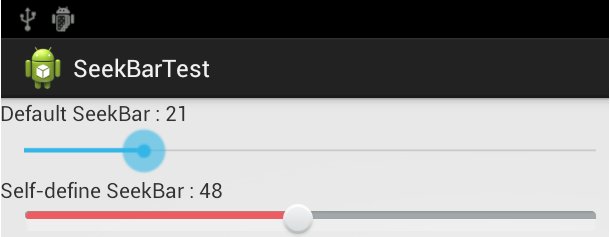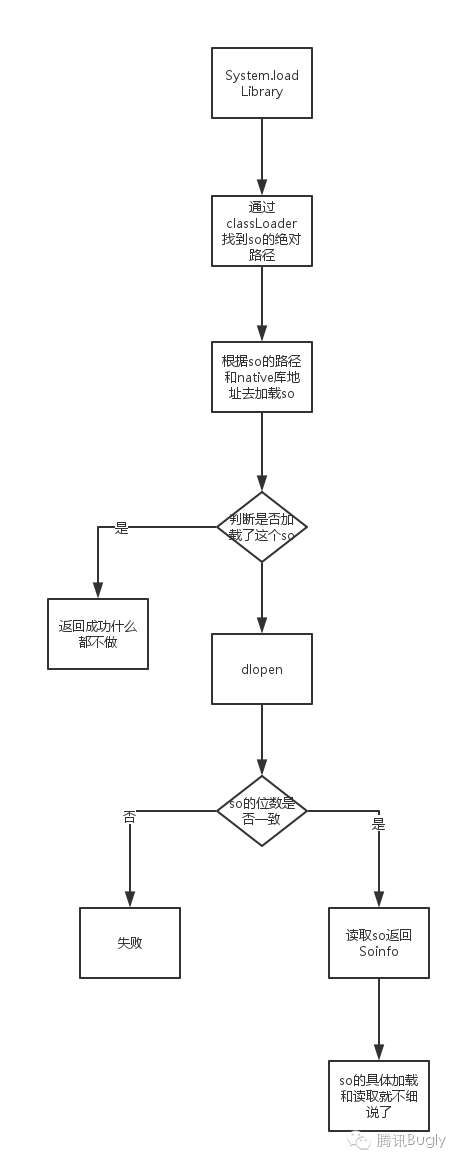編輯:關於Android編程
1 SeekBar簡介
SeekBar是進度條。我們使用進度條時,可以使用系統默認的進度條;也可以自定義進度條的圖片和滑塊圖片等。
2 SeekBar示例
創建一個activity,包含2個SeekBar。
第1個SeekBar是系統默認的SeekBar。
第2個SeekBar是自定義SeekBar,使用自定義的背景圖和滑塊圖片。
應用層代碼
package com.skywang.control;
import android.os.Bundle;
import android.app.Activity;
import android.util.Log;
import android.widget.TextView;
import android.widget.SeekBar;
import android.widget.SeekBar.OnSeekBarChangeListener;
public class SeekBarTest extends Activity implements SeekBar.OnSeekBarChangeListener{
private static final String TAG = "SKYWANG";
// 與“系統默認SeekBar”對應的TextView
private TextView mTvDef;
// 與“自定義SeekBar”對應的TextView
private TextView mTvSelf;
// “系統默認SeekBar”
private SeekBar mSeekBarDef;
// “自定義SeekBar”
private SeekBar mSeekBarSelf;
@Override
protected void onCreate(Bundle savedInstanceState) {
super.onCreate(savedInstanceState);
setContentView(R.layout.seek_bar_test);
// 與“系統默認SeekBar”對應的TextView
mTvDef = (TextView) findViewById(R.id.tv_def);
// “系統默認SeekBar”
mSeekBarDef = (SeekBar) findViewById(R.id.seekbar_def);
mSeekBarDef.setOnSeekBarChangeListener(this);
// 與“自定義SeekBar”對應的TextView
mTvSelf = (TextView) findViewById(R.id.tv_self);
// “自定義SeekBar”
mSeekBarSelf = (SeekBar) findViewById(R.id.seekbar_self);
mSeekBarSelf.setOnSeekBarChangeListener(this);
}
/*
* SeekBar停止滾動的回調函數
*/
@Override
public void onStopTrackingTouch(SeekBar seekBar) {
}
/*
* SeekBar開始滾動的回調函數
*/
@Override
public void onStartTrackingTouch(SeekBar seekBar) {
}
/*
* SeekBar滾動時的回調函數
*/
@Override
public void onProgressChanged(SeekBar seekBar, int progress,
boolean fromUser) {
Log.d(TAG, "seekid:"+seekBar.getId()+", progess"+progress);
switch(seekBar.getId()) {
case R.id.seekbar_def:{
// 設置“與系統默認SeekBar對應的TextView”的值
mTvDef.setText(getResources().getString(R.string.text_def)+" : "+String.valueOf(seekBar.getProgress()));
break;
}
case R.id.seekbar_self: {
// 設置“與自定義SeekBar對應的TextView”的值
mTvSelf.setText(getResources().getString(R.string.text_self)+" : "+String.valueOf(seekBar.getProgress()));
break;
}
default:
break;
}
}
}
代碼說明:
要監聽SeekBar的滑動消息,通過實現“SeekBar.OnSeekBarChangeListener”接口。這個接口中包含3個方法onStartTrackingTouch()、onStopTrackingTouch()和onProgressChanged()。
layout文件
<LinearLayout xmlns:android="http://schemas.android.com/apk/res/android"
xmlns:tools="http://schemas.android.com/tools"
android:layout_width="match_parent"
android:layout_height="match_parent"
android:orientation="vertical" >
<TextView
android:id="@+id/tv_def"
android:layout_width="wrap_content"
android:layout_height="wrap_content"
android:text="@string/text_def" />
<!--
max=100,代表它的取值范圍是0-100,共101個值;
progress=10,代表默認值是10
-->
<SeekBar
android:id="@+id/seekbar_def"
android:layout_width="620px"
android:layout_height="wrap_content"
android:max="100"
android:progress="10"
/>
<TextView
android:id="@+id/tv_self"
android:layout_width="wrap_content"
android:layout_height="wrap_content"
android:text="@string/text_self" />
<!--
max=100,代表它的取值范圍是0-100,共101個值;
progress=20,代表默認值是20
progressDrawable,表示SeekBar的背景圖片
thumbe,表示SeekBar的滑塊圖片
-->
<SeekBar
android:id="@+id/seekbar_self"
android:layout_width="620px"
android:layout_height="wrap_content"
android:max="100"
android:progress="20"
android:progressDrawable="@drawable/bg_bar"
android:thumb="@drawable/thumb_bar" />
</LinearLayout>
自定義SeekBar的背景定義為:android:progressDrawable="@drawable/bg_bar"。
它調用的bg_bar.xml的內容如下:
<?xml version="1.0" encoding="utf-8"?> <layer-list xmlns:android="http://schemas.android.com/apk/res/android"> <!-- 背景圖 --> <item android:id="@+android:id/background" android:drawable="@drawable/bar_dn" /> <!-- 第二進度圖 --> <item android:id="@+android:id/SecondaryProgress" android:drawable="@drawable/bar_dn" /> <!-- 進度度 --> <item android:id="@+android:id/progress" android:drawable="@drawable/bar_up" /> </layer-list>
bar_dn.png如下圖:

bar_up.png如下圖:

自定義SeekBar的滑塊定義為:android:thumb="@drawable/thumb_bar"。
它調用的thumb_bar.xml的內容如下:
<?xml version="1.0" encoding="UTF-8"?>
<selector xmlns:android="http://schemas.android.com/apk/res/android">
<!-- 按下狀態 -->
<item android:state_pressed="true"
android:drawable="@drawable/thumb_dn" />
<!-- 焦點狀態 -->
<item android:state_focused="true"
android:drawable="@drawable/thumb_up" />
<!-- 默認狀態 -->
<item android:drawable="@drawable/thumb_up" />
</selector>
thumb_up.png如下圖:

thumb_dn.png如下圖:

manifest文件
<?xml version="1.0" encoding="utf-8"?>
<manifest xmlns:android="http://schemas.android.com/apk/res/android"
package="com.skywang.control"
android:versionCode="1"
android:versionName="1.0" >
<uses-sdk
android:minSdkVersion="8"
android:targetSdkVersion="17" />
<application
android:allowBackup="true"
android:icon="@drawable/ic_launcher"
android:label="@string/app_name"
android:theme="@style/AppTheme" >
<activity
android:name="com.skywang.control.SeekBarTest"
android:label="@string/app_name" >
<intent-filter>
<action android:name="android.intent.action.MAIN" />
<category android:name="android.intent.category.LAUNCHER" />
</intent-filter>
</activity>
</application>
</manifest>
點擊下載:源代碼
運行效果:如圖

以上就是本文的全部內容,希望對大家的學習有所幫助,也希望大家多多支持本站。
 四大組件之Activity(下)——Activity的常用Manifest屬性、啟動模式、ADB調試
四大組件之Activity(下)——Activity的常用Manifest屬性、啟動模式、ADB調試
第5節 Activity的Manifest配置5.1 Activity的聲明Activity作為四大組件,代碼中每定義一個Activity就需要在AndroidManif
 Android連接Wifi詳細源碼
Android連接Wifi詳細源碼
因項目需求,做一個有關wifi的Demo,現已經上傳到GitHub 上面地址:https://github.com/git-xuhao/WifiDemo源碼片段packa
 Android ToolBar使用
Android ToolBar使用
Android Toolbar:ToolBar是Android 5.0(API Level 21)之後用來取代ActionBar的ToolBar的優勢:Toolbar本身
 動態鏈接庫加載原理及HotFix方案介紹
動態鏈接庫加載原理及HotFix方案介紹
引言隨著項目中動態鏈接庫越來越多,我們也遇到了很多奇怪的問題,比如只在某一種 OS 上會出現的 java.lang.UnsatisfiedLinkError,但是明明我們